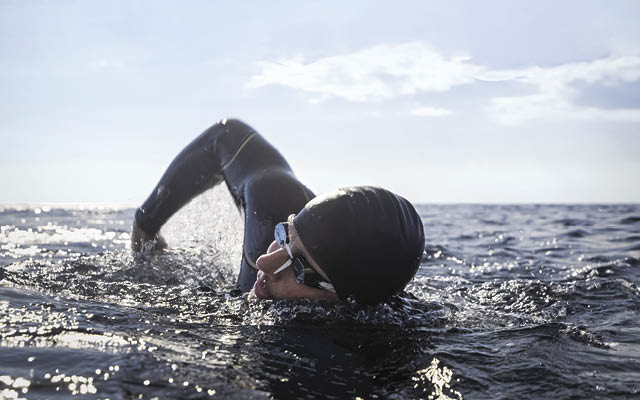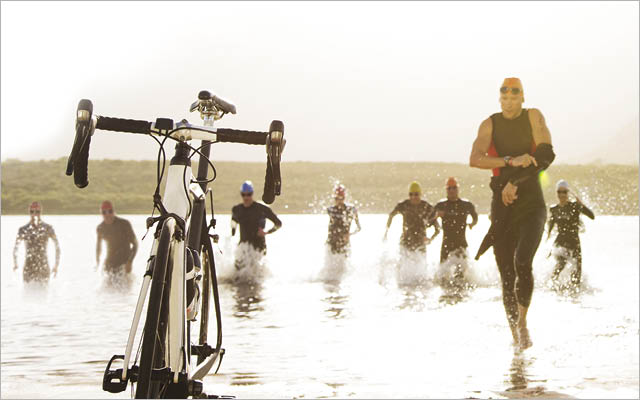Perhaps you’re a devout jogger, but your training regimen needs a kick in the running shorts. Hey, a 10K might be just the ticket! Or maybe you’ve cross-country skied for years. Aren’t you a little curious to see how you stack up against others your age?
Whoever you are and whatever your sport, preparing for and participating in a competitive athletic event can add more motivation, structure and fun to your workouts. Every year, thousands of casual runners, bikers and cross-country skiers enter races for the very first time. With nary a thought of taking home top honors, these citizen athletes train hard, push past their limits and, as they cross the finish line, enjoy their own personal moments of glory. You can, too – even if you don’t think you have a competitive bone in your body.
Just being part of an athletic community, or participating in an event for a good cause, can be incredibly inspiring. Racing can also help you reach long-term fitness objectives, like weight loss or improved cardiovascular health, by allowing you to concentrate on the easier-to-reach short-term goal of crossing a finish line.
“There’s a lot of delayed gratification in wanting to lose 15 pounds,” explains Rick Aberman, PhD, a Minneapolis-based sports psychotherapist. But completing a race, he says, is an exact, concrete accomplishment. Each finish line is a precise point in space; the instant you cross one, you’ve achieved what you set out to do. There’s no waiting around for the bathroom scale to tell you where you stand. And no matter how you perform, just participating in an athletic event makes you an athlete. That can dramatically change how you see yourself and your fitness pursuits, and make your workouts both more meaningful and more satisfying from the moment you decide to register.
Finding a Race That’s Right For You
No matter your sport, there’s an event that’s right for you. When searching for your ideal debut race, consider the following tips:
Running: Of all the endurance sports, running is the least complicated in terms of gear and technique (you can get basic tips by reading “In Good Form.“) Whether you’re doing a 5K (3.1 miles) or a longer race, rest assured that legions of your fellow competitors will also be amateurs more invested in fitness motivation than racing position. If you’re just getting started, you’ll be in good company on almost any running course.
Cycling: Stick with “road races,” which follow long, varied routes rather than set, circular courses. Road races are less crowded and, thus, less accident-prone than other cycling events.
Cross-Country Skiing: Because skiing is a sport that’s highly dependent upon good equipment, practiced technique and good form, courses that are hilly and hard-to-navigate are not good places to get your competitive start. Instead, sign up for a race held on a flat, 10- to 15-kilometer course at a local park or golf course.
Triathlon: Thanks to the proliferation of sprint-distance and relay triathlons, triathlon is evolving into a beginner-friendly sport. Good first-time tri’s include the Bethesda CAN (Cure Autism Now) Triathlon in Maryland every April, or any of the Danskin Women’s Triathlon Series, in various cities across the country throughout the year.
Swimming: If you swim laps, you know not to be fooled by distances. While a 1-mile swim doesn’t sound all that far, it makes for a grueling event. Many gyms and public pools throw amateur-friendly meets. Oceanside and lakeside communities often host open-water races, which can be more challenging. Want to avoid biting off more than you can chew? Consider taking on the swim portion of a sprint-distance triathlon as part of a relay team.
Your Registration
Registering for a race is usually as easy as filling out a form (generally just name, address and age) and sending it in along with your race fee. Many races, especially larger, more popular ones, require you to register in advance (sometimes as long as six months to a year ahead of time). For local races and fun-run events, registration may be open right up to the event.
Registration fees are, as a rule, nonrefundable. Still, if you can’t make it and if your race is sponsored by a nonprofit, you may be able to convert a portion of your entry fee into a tax-deductible donation. Just ask.
Looking for a suitable local event? Check out your local cycling, running and skiing shops. Many race directors still spread the word about their events by distributing flyers and paper entry forms at local specialty stores. The best stores have dozens of entry forms on display, giving a panoramic view of up-coming races. What’s more, knowledgeable employees can usually direct you toward beginner-friendly events.
If you prefer to do your research and registration via the Web, you can find dozens of sites designed to help you locate local, regional and national races. Active.com offers the most comprehensive listing of events. There you’ll find nationwide listings that make it easy to handpick your debut race. For most races listed, the site allows you to register and pay instantly. Confirmation arrives moments later via your email inbox.
Your Day
You’ve kept up with your training, filled out the proper forms and paid your entry fees. You’re ready to race – except that you have no idea what you’re doing. No worries! Follow these suggestions and you’ll pass for a pro:
The Mark: By the time you enter the staging area (a.k.a. the starting lineup), you should be marked with your bib and wearing your race chip (see “Victory Vocabulary” below to learn the lingo). Both items need to be picked up in advance, usually an hour or more before the race. Larger-scale events often distribute those materials at a separate “packet pick-up” event, one to three days out. Read your confirmation carefully so you know the drill.
The Lineup: Peter Spencer, race coordinator for the 5K Reindeer Run in Troy, Mich., suggests that when lining up at the start, new racers should stay in the middle or back of the pack so they don’t hold up elite racers. This will ? also save you from getting passed more than necessary (an important psychological consideration). If you’ve set a goal for time, sneak as close to the front as you’re comfortable. Triathlon and swimming events, however, usually start in staggered groups (called “waves”), with competitors assigned specific start times. Double-check your race confirmation so you know where to be and when.
The Etiquette: Courses are heavy traffic zones, filled with racers of varying speed and ability levels. You can help ease congestion by being courteous to other racers. If someone says “on your left,” move to the right to make way. When you want to pass someone, give him or her the same courteous heads-up.
The Finish: Once you’ve crossed the finish line, keep moving! If you come to a dead stop, you could cause a traffic jam. Volunteers will be on hand to distribute prizes and collect race chips as you continue through, and postrace goodies usually await you just beyond the finishing chute. Once you’ve made it there, it’s generally fine to linger.
The Results: Some officials make race results immediately available, often by posting long scrolls near the finish. More often, however, you need to wait a few days to access results online. In some cases, it’ll take a few weeks to receive an official postcard via mail. Specific information about accessing your results is usually found on your entry form or race confirmation.
Everybody Wins
If all you know of athletic competition is the stuff of Olympic news coverage (vicious competition, the agony of defeat and all that), you might be surprised to learn that real-life racing can be downright friendly! From the middle of the pack to the very back, many race participants encourage one another. They’re invested mostly in racing against themselves and having a good experience. Bruce Krell, a 49-year-old runner from Phoenix, who recently did his first 5K and is working toward a half-marathon, says he’s never cared much about placing first, or placing, period. “I race for good health and peace of mind – not to beat anybody,” he says. “The goal is to finish and to feel good about myself,” he explains. Sounds like a winning attitude to us.
Race Day Lingo
Don’t know a race chip from a cow chip? Get versed in competitors’ vernacular with this crash-course glossary, designed to help you talk the talk on race day:
- Age-Groupers: Many race directors organize competitors into five- to 10-year age categories, allowing 40-somethings to compete against each other, rather than taking their chances against 20-year-olds. The term “age-grouper” is used interchangeably with “amateur.”
- Bib: Your bib is your race number, which allows officials to track and clock you. At running and skiing events, your bib will be a slip of paper, which is pinned to your shirt. Swimmers, cyclists and triathletes often use markers to scrawl their bibs across arms and legs.
- Bonk: To get so depleted of glycogen and blood sugar that you feel you cannot continue or perform at a normal level. Also referred to as “hitting the wall.”
- Chip Time and Gun Time: In large events, you’ll have to begin the race well behind the official starting line rather than at it. Often, you’ll be issued a small “race chip,” which is strapped onto your body. Chip time begins the instant you cross the starting line. On the other hand, gun time is measured from the race’s official start. Most racers give more credence to chip time. If your race doesn’t use race chips and you want to know your race time, wear a watch with a stopwatch. Just start and stop it as you cross the start and finish lines.
- Masters Division: Typically, competitors age 40 and older.
- PR: Abbreviation for “personal record” – your best time achieved in any given race.
Essential Tips for Picking, Preparing, and Racing
When picking, preparing for and racing your inaugural event, keep these general tips in mind.
Do’s:
- Do train with a friend, club or fundraising team. Use your workouts as an excuse to catch up with old friends – or to meet new ones.
- Do race with a heart-rate monitor and decide in advance the target zone or rate at which you’ll be working (ideally, you’ll be under your anaerobic threshold most of the time). Keep in mind your heart rate might be a few beats higher than normal if you’re nervous, particularly at the start. But don’t abandon your chosen zone, or you’ll be far more likely to “bonk.”
- Do write your name across the back of your jersey so fans can root for you by name. This will give you a mental boost to get through the toughest parts of the course.
- Do thank volunteers. From manning water stops to stopping traffic, volunteers make race day smooth and enjoyable. Without them, your event wouldn’t be possible.
Don’ts:
- Don’t enter an event that’s unfriendly to amateurs. Don’t make the experience more intimidating than it needs to be by starting on a course that’s too difficult or dominated by elite athletes. Pick an event that touts itself as low-pressure and lots of fun.
- Don’t forget your bib or race chip. Without them, race officials can’t time you. You’ll have no physical evidence of having completed the event.
- Don’t use the race as an excuse to push yourself beyond healthy limits. If you feel sharp pain or become breathless, slow down – and if necessary, stop.
- Don’t screech to a dead halt the second you cross the finish line. You’ll need a cool-down. Plus, stopping too suddenly can create a logjam for other racers.




This Post Has 0 Comments